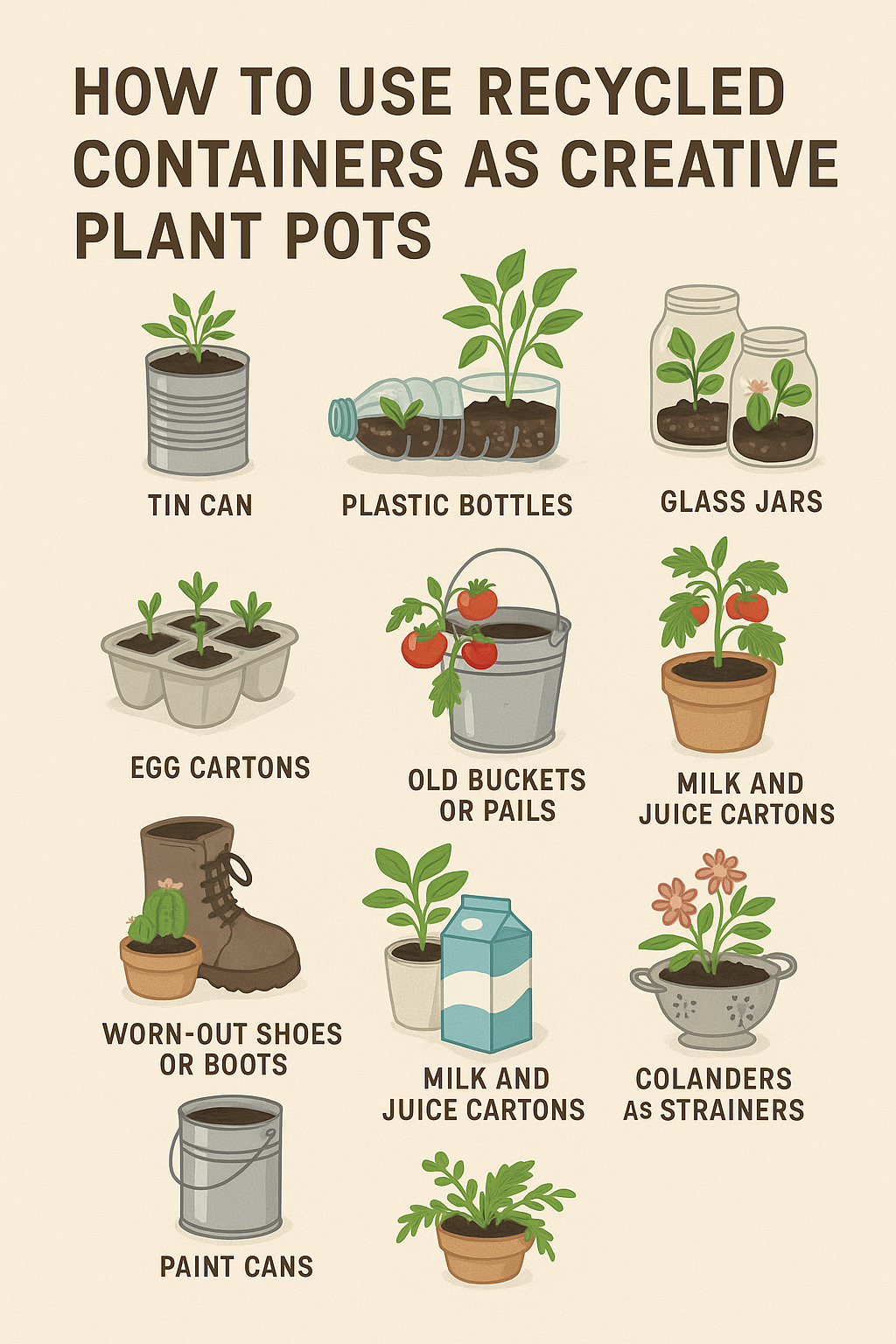You don’t need fancy ceramic pots or expensive planters to start growing beautiful plants. In fact, some of the most charming and eco-friendly plant containers can be made from everyday items you already have at home. Reusing containers not only saves money but also gives your garden a unique personality while helping reduce household waste.
In this article, you’ll learn how to turn common recycled items into creative plant pots — with tips on drainage, decorating, and plant pairing.
Why Use Recycled Containers for Planting?
Recycled containers offer several advantages, especially for gardeners on a tight budget:
- Eco-friendly: Reduces waste and landfill contribution.
- Budget-saving: Eliminates the need to purchase new pots.
- Creative: Each container has character and tells a story.
- Customizable: You can paint, decorate, or reshape them as you wish.
From tin cans to teacups, the possibilities are endless.
1. Tin Cans
Tin cans from beans, soup, or vegetables make excellent small planters.
How to Prepare:
- Wash thoroughly and remove labels.
- Poke holes in the bottom for drainage (use a hammer and nail or drill).
- Optionally, paint or decorate with twine, stickers, or washi tape.
Great for: Herbs, succulents, or small flowers like marigolds.
2. Plastic Bottles
Water and soda bottles can be repurposed into hanging or standing planters.
Options:
- Cut horizontally to make open containers.
- Cut vertically to hang on fences or walls.
- Create self-watering planters by inverting the top into the base.
Great for: Leafy greens, strawberries, or small ferns.
3. Glass Jars
Old sauce jars or mason jars are ideal for water-based or decorative plants.
Best for:
- Water propagation: Use for pothos, basil, or mint cuttings.
- Succulent displays: Layer pebbles, charcoal, and soil.
- Mini terrariums: For moss, fittonia, and other tiny plants.
Note: Glass jars usually lack drainage. Add a drainage layer or water carefully.
4. Teacups and Bowls
Cracked or mismatched crockery gets new life as charming planters.
Tips:
- Drill a drainage hole if possible.
- If not, place small rocks at the bottom before adding soil.
- Don’t overwater — use a spray bottle if needed.
Great for: Cacti, succulents, or decorative houseplants.
5. Egg Cartons
Egg cartons are perfect for seed starting.
How to Use:
- Fill each cell with potting mix.
- Add a seed per cell and water gently.
- Once seedlings sprout, transplant directly (if using biodegradable cartons).
Great for: Starting herbs, lettuce, tomatoes, or flowers.
6. Old Buckets or Pails
Metal or plastic buckets are ideal for larger plants.
Tips:
- Ensure drainage by drilling holes at the bottom.
- Add a layer of gravel before the soil.
- Use handles for easy transport around your space.
Great for: Tomatoes, peppers, bush beans, or even small fruit trees.
7. Worn-Out Shoes or Boots
Got an old pair of boots lying around? They make quirky and memorable planters.
How to Use:
- Clean and cut drainage holes in the soles.
- Fill with soil and place on your porch or garden path.
Great for: Trailing plants like ivy or small flowering plants.
8. Milk and Juice Cartons
These are easy to cut and shape into temporary or long-term planters.
Best used for:
- Starting seedlings.
- Kids’ gardening projects.
- Indoor herb gardens.
Make sure to cut off the top, add drainage holes, and reinforce with tape if needed.
9. Paint Cans
Leftover paint cans are great for modern, metallic-looking planters.
To prepare:
- Clean thoroughly to remove any toxic residue.
- Add drainage holes and paint the exterior if desired.
Great for: Medium-sized houseplants, palms, or ferns.
10. Colanders and Strainers
Colanders already have built-in drainage — perfect for plants!
How to Use:
- Line with landscaping fabric or burlap to hold soil.
- Add soil and plant normally.
- Hang from chains or place on shelves.
Great for: Hanging strawberries, herbs, or trailing flowers.
Decoration Ideas for Recycled Planters
Want to add a touch of style to your containers? Try these simple ideas:
- Paint with acrylics or spray paint for a modern or rustic look.
- Wrap in jute rope or twine for a natural feel.
- Use chalkboard paint to label each plant.
- Attach knobs or legs to jars and cans for a “mini pot” effect.
- Add buttons, beads, or mosaic tiles for a colorful design.
The only limit is your imagination.
Important Considerations for Recycled Planters
- Drainage: Always add holes or create a drainage layer (pebbles or charcoal).
- Material safety: Avoid containers that held toxic chemicals.
- Size: Match the container size with your plant’s root needs.
- Sun exposure: Metal containers heat up faster — keep them in shade if needed.
Final Tip: Start Small, Stay Creative
Recycled gardening is all about starting with what you have. No need to buy anything fancy — just look around your home for unused containers, and let creativity lead the way.
From a single yogurt cup on your windowsill to a full display of tin cans and teacups on your patio, every small step helps your plants grow — and helps the planet too.
